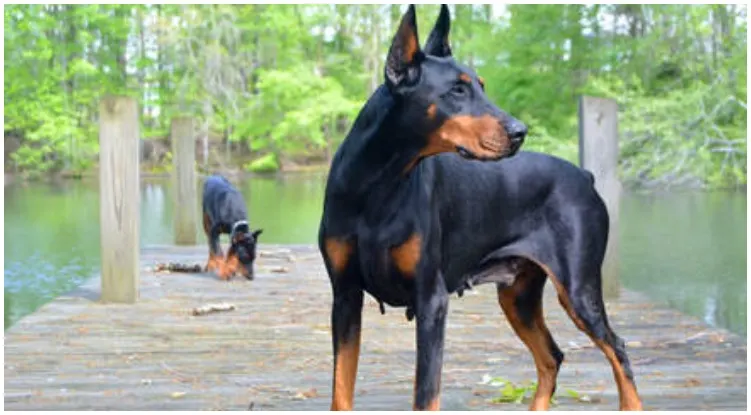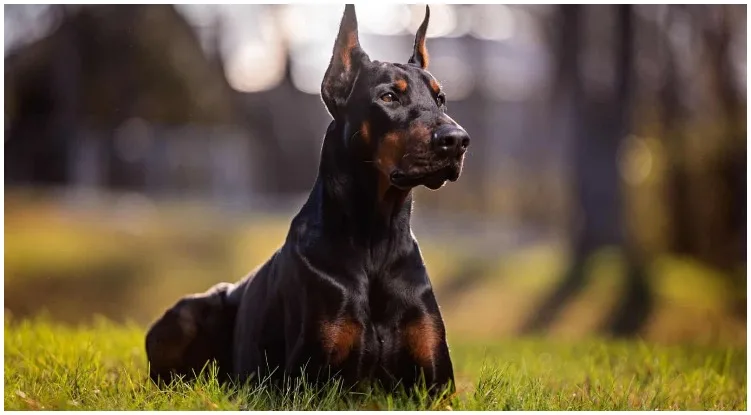We all know about the Doberman breed. But did you know that they are actually separated into two categories: The American and European Doberman. Obviously, here in the US the American Doberman is much more common. But you shouldn’t overlook the second one either. Let’s go over the main differences and learn what to expect from the European Doberman.
History
The first European Doberman (or Doberman in general) was bred in Germany in the 1890s. The creator of this breed was Friedrich Louis Dobermann, which also explains where they got their name from. Louis was a tax collector, and he wanted to create a dog breed to help him with his then risky job.
Karl started crossbreeding different dog breeds in order to make the perfect guardian dog. Even though it’s unknown which breeds and in which ratio were used to create the Doberman, they probably included the Beauceron, the Rottweiler, the Weimaraner, and the German Pinscher.
Otto Goeller, continued to breed the breed after Louis Dobermann’s death. He did make some differences during the breeding, perfecting the Doberman and creating the dog we know today.
Dobermans came to the US during the First World War. As the Doberman is a working breed, he was a great addition to the military. In the USA the Doberman was even awarded the “Marine War Dog”. Even today many Dobermans are trained as guard dogs, police and rescue dogs.
The bad reputation, which sometimes arouses a great fear of Dobermans among many people is just not justified in most cases. While they are naturally good guardians, early socialization with humans and animals is key.
The Doberman of today, an elegant light-footed dog with noble features, loves to be near his owners.
Fun facts about the European Doberman
- The Doberman is one of the only dog breeds to have the name of its founder: Friedrich Louis Dobermann.
- A Doberman named Kurt saved a squad of US Marines from a grenade in 1944 in the Battle of Guam. He’s the first dog buried in the National War Dog Cemetery.
- Prominent Dobi holders are or were Silvester Stallone, John F. Kennedy and Mariah Carey.
- The Doberman is a Film Star. In the 1972’s a film called, The Doberman Gang was released. It’s a film about “six savage Dobes with a thirst for cold cash that leaves banks bone dry.”
- The Dobermans DNA suggests a strong connection to German Shepherd ancestry. Meaning that the same genetic makeup used to protect and herd livestock runs through the veins of the Doberman.
- Dobermans are AKC registered. The Doberman was recognized as a breed by the American Kennel Club AKC in 1908.
Difference between European and American Doberman
You might be confused how the European Dobermann is even different from the American Doberman Pinscher. The main difference is that the European Doberman is a slightly larger, more muscular dog with a high drive and a temperament better suited for use as a working dog. The American Doberman is more of a show dog, and has more elegance to it.
The European Doberman is a slightly larger dog with more muscle mass and a shorter, thicker neck. This European variety has a high drive and is very suitable for personal protection or other working dog operations. The American Doberman Pinscher is a slightly smaller, slimmer and some argue that the dog looks more “elegant”. These dogs have thinner necks that seem to stand out bent from the body. They are generally quieter and better suited as family pets. Despite the differences between these two varieties, it is the same breed of dog.
The differences certainly go deeper than that, however, these dogs are still pretty similar. They are also certain differences in their temperament. The European Doberman is more alert, protective and a better watchdog than the American Doberman. European Breeders do mostly produce European Dobermans, while the Pinscher is more common in the United States.
Appearance
While being quite large, the Doberman is still compact, athletic and muscular. They have short coats in one of the following colors: Black, red, blue or fawn.
Dobermans have naturally long tails and medium-sized pedant ears. They usually stand on their toes. That gives them an elegant appearance.
Male Dobermans weigh around 88-99lbs (40 to 45 kg) and are 27-28 inches tall (68 to 72 cm). While a female Doberman weighs between 71-77lbs (32 to 35 kg) and is usually between 25-27 inches tall (63 to 68 cm).
Personality
Dobermans are a highly alert breed, which makes them amazing watchdogs. Many people believe that they are aggressive, however, they are not. If trained correctly, they are social and well-rounded canines. They are stubborn, passionate and natural born leaders. But they are also in tune with the emotions of their owners, and are very loyal and loving. There is a soft side to every Doberman, but they show it only to a few people.
Dobermans can be dominant, which is why it’s so important to train them from an early age. Owners have to establish themselves as the leader of the pack, or else their dog will think he can do whatever he pleases. But they are also very confident and will know how to act even in unfamiliar situations.
They are very protective towards their family. If your Dobermans feels that you are in danger — he will do whatever it takes to protect you.
Trainability and Exercise
This intelligent breed is very capable of learning. They are smart, talented, learn quickly and are mostly easy to train.
However, you have to start the socializing process from an early age. This is crucial for all Dobermans, either American or European. They need to get used to other dogs and humans. This will help them control their aggressive and destructive behaviors and make the a great family dog.
Many training techniques will work great for them. Verbal praise and rewards in the form of treats are always welcome.
These dogs are born to be active! They thrive on exercising, and need it to stay healthy and happy. Additionally, their high intelligence also requires mental stimulation. This will also help them stay away from their destructive behaviors.
They don’t having nothing to do or sit inside all day. If you have a busy schedule and can’t exercise with your dog for at least 30-45 minutes a day, than this isn’t the breed for you. Long walks through the dog park and chasing around in the fields will be a must.
Grooming
The European Doberman is incredibly easy to groom. These are low maintenance dogs, at least when it comes to grooming. They have naturally short coats and shed very little. However, their coat does require weekly brushing with a bristle brush.
Additionally, their nails grow fast, so they will have to be trimmed regularly. And don’t forget to clean their ears and brush their teeth either.

Health and Life expectancy
Health is a big issue for Dobermans. Due to false priorities, ignorance and mistakes in breeding in the past, they have to struggle with a number of breed-specific diseases. These diseases unfortunately still occur very frequently even with the best care and nutrition.
These hereditary diseases include dilatative cardiomyopathy, a very aggressive disease of the heart that can also lead to sudden cardiac arrest in otherwise healthy dogs. It does not occur as often in any other breed of dog as in Doberman.
In addition, there are other health problems such as congenital vestibular syndrome, which leads to numbness and balance disorders, wobbler syndrome, which causes serious damage to the spinal cord of the cervical spine, and blood clotting disorders.
Other health issues that aren’t so Breed specific to Dobermans include: Von Willebrand’s disease, hip dysplasia, hypothyroidism, albinism.
These last conditions can be prevented with regular exercise and a balanced and healthy diet. Also make sure you get your European Doberman puppy from a reputable Doberman breeder.
The life expectancy of the dog breed is on average 8 to 13 years and, as with all dogs, strongly depends on health, care and origin.
Unfortunately, the Doberman is a prime example of breeding dogs where much more attention is on their appearance than on health. That’s why a few decades ago their life expectancy was only 7 years.
Meanwhile, breeding regulations have been tightened up. More attention is now paid to a natural and healthy appearance, which increases the life expectancy of the animals again.
While you’re here, why not learn about other dog breeds as well:
- Bernedoodle puppies: Five facts to know!
- Schnoodle puppies: The cutest hybrid breed ever
- Golden retriever Chow mix: Golden Chow
- Pitbull Beagle Mix: A very unusual hybrid dog
- Pitbull Dachshund Mix: Complete Guide

